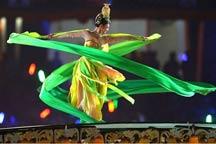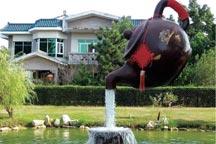Roast Nang (flat bread)
When you come to Kashi, whether it is in a city, countryside, a street or an alley, on a jubilation-wedding banquet, or in a camel team, you can find and taste a kind of round roasted bread, i.e. the traditional Uyghur staple food - Nang. It is everyday food of Uyghur, which is as important as steamed breads to the northerners and rice to the Southerners.
According to textual research, the word Nang came from Persian, which was popular in Arabian Peninsula, Turkey, center Asia various countries. Uyghur originally called it “Aimaik”, after Islam was spread to Xinjiang it was changed for “Nang”.
At present there are approximately 50 kinds of Nang, such as Nang with meat, oil, sesame, and so on. Different Nangs are for different occasions. Big Nangs such as "Aimaike" and "Shearman" are mainly for holidays and joyous occasions. Small portable Nangs such as "Tuachi" and "Katili" are food while people out touring or working.
Most nangs are baked with wheat-flour, corn or rice flour. They are named from their ingredients, shape and roast methods. Nang with lamb oil in it are called oil Nang, Nangs with ziyadan (seeds of a kind of grass), mutton cubes and spices such as pepper and onion fillings are meat Nang; Nangs with sesames and grape are called sesame Nang.
Nangs are baked in a stove called tonnir that has a big stomach and a little mouth that is made from sun-dried earth bricks. First heat the tonnir with firewood or charcoal. When the flame is to extinguish, put the dough on the inside walls of the tonnir. About 20 minutes later Nang is ready to eat.
Hot Nang is crisp and tasty. Uyghur often eat it with tea and mutton Kebab (roast mutton). In autumn, when grapes are ripe, they eat it with grapes, which are said to be more tasty and nutritious. Nang with only a little water in it do not go moldy easily and is easy to preserve. In harvest seasons, farmers usually carry with them several dozens of Nangs.
So do those out traveling or working in the Gobi desert. A few minutes after they bury nang under the hot sand, it will become crisp and delicious. A nang with a history of 1000 years has been evacuated which still did not go mold. It is said that when Chinese monk Xuanzang of Tang Dynasty went through Gobi desert he had nangs with him that fended him off hunger. According to record, as early as Han or Wei Dynasty, there were Nangs selling in the markets of Chang’an. It is also said that, after “the revolt of An Lushan of Shi Siming”, Xuanzong of Tang Dynasty ate Nang bought by the brother of Yang Guifei.
Roast Meat
Roast meat is the most attractive food among the local delicacies in Xinjiang. There are a great variety of roast meat such as the kebob, chopped entrails, whole lamb, meat baked in tonnir, etc. If you do not taste roast mutton after you reach Xinjiang, it would be a great pity. Kashi mutton is unique in that sheep are fed with grass grow on land rich in alkaline. So mutton here is more delicious.
(1) Kebob. One can find Kebobs in every bazaar or street of Kashi. It is roasted above a special iron oven about 1 meter long and 20 centimeters wide. Some have two layers, separated by clapboard with countless vents. In the past charcoal is used but now coal has replaced it. Light the charcoal fire until it nearly burn out, then lay the sliced mutton over it with refined salt, chili powder, and ziyadan. If there is no breeze, the cook will use a thin wooden board to increase the fire. He will turn the meat bunch continuously. In five minutes, the delicious kebob is ready. Recently, electric oven are used which are more convenient and efficient.
Kebobs are popular in Xinjiang. Some can eat several dozen of bunches at one time. In winter, customers sit in front of the roast meat stand, eating Kebobs while getting warmth by fire.
According to archaeological materials, as early as 1800 years ago, there are kebobs in the central plains of China.
(2) Meat Roasted in Tonnir This kind of barbecue is roasted from the heat in the tonnir (a special oven for baking Nang). Heat the tonnir with firewood. Then put square mutton with a side length of about ten centimeters dipped in a paste mixed with egg, refined salt, first-class flour, and ziyadan on the inside wall of the tonnir. Cover the tonnir with lighting wood. Thirty minutes later, take the meat out, cut them into small pieces, and eat them with refined salt.
(3) Roast Lamb. It is one of the most famous dishes in Xinjiang and usually served on important banquets. Roast lamb is a magnificent thing. The complex flavor is bold yet delicate, the texture is a study in contrasts between the crisp, flavorful exterior and the tender, juicy interior, and the heady aroma brings a tear of joy to the eye and a bit of drool to the chin.
Polo
Polo (the cooking material of which is mainly mutton, carrot, oil and rice) is one of the local flavors of the Uyghur, Uzbeks, etc. with which to entertain their guests. On festive occasions or at the wedding breakfast, polo is indispensable for treating the guests. The traditional custom of dining is that the guests are asked to sit round the kang, in the centre of which a clean tablecloth is laid. The host or hostess, with a basin in one hand and a kettle in the other, asks the guests to drip-wash their hands one by one, and hands them a towel to clean their hands. After the guests have sat down, the host will carry several trays of polo and invite them to eat it directly from the tray by hand.
Cooking method and its legend: Its cooking material is mainly mutton, carrot, oil and rice. First cut mutton into small square and cook it with edible oil. After a while, add some onion, carrots, water and refined salt. Twenty minute later put rice in. Wait for another forty minutes, polo is done.
The legend goes like this. It is said that more that one thousands years ago, a doctor named Abuduaili was in poor health in his old age. No medicine can help him. Later, he cooked a meal for himself and ate it two times a day. Half a month later, he recovered. His neighbors was amazed by the fact and asked him about it. He told the secret to them and the recipe was passed around. That’s is polo today.
Thin-wrapper steamed stuffed bun (Pitimantuo in Uyghur)
It is a kind of steamed bun having mutton and onion as fillings. It is so-called because its wrapper is as thin as a piece of paper. First chop the mutton, beef and sheep’s-tail fat into small cubes. Add chopped onions, salt and pepper to make the stuffing. Wrap the stuffing in dough, and put in bamboo steamer to cook for 20 minutes. The steamed buns are thin-skinned, with tender meat stuffing and very delicious. The Uygurs often eat these together with nang (crusty pancakes) and rice to be eaten with the hands.
Lamian Noodles (Pulled Noodles)
Lamian noodles, known in Chinese as Lamian or Lamiantiao are popular with many ethnic groups in Xinjiang and the rest of China. The noodles are pliable and tough, smooth and delicious. The name ’Lamian’ means ’pulled noodles’. The noodle dough is pulled in a special way to create thinner and thinner strings of dough, and finally, noodles! Then the noodles are boiled quickly and various ingredients are added, including oil, mutton pieces, cooked tomato and chili peppers. Sometimes the noodles are stir-fried along with these ingredients, which can only be described as a totally different, yet equally delicious taste.
Yogurt
Yogurt is a kind of zymolytic dairy products great favored by Uygur people. Throughout the year, Uyghur people of all ages like to drink it.
The secret lies in its nutrition. Its nutritive value far exceeds fresh (sheep) milk. It contains many kinds of lactic acids, milk sugar, amino acid, mineral substances, vitamin, enzyme, etc. The protein that it contains is higher than that of rice, flour, and meat.
Stewed Mutton Cubes
This is a Xinjiang dish prepared especially for festivals. Cut mutton into cubes of 500 grams apiece and boil them in a big pot. When they are half done, remove the foam; and when they are 80 percent done, ass onions, pepper, ginger slices, carrots, turnips and tomatoes. Then remove and place on a big plate. Put some salt in the stock and remove to a bowl. Before eating the mutton, dip it in the stock.
Rice Eaten with Hands
The materials are fresh mutton, carrots, onions, vegetable oil, melted sheep’s fat and rice. There are more than 10 kinds of this rice dish, mainly mutton, chicken and vegetarian, but the most common is the one using mutton. This food is soft, delicious and nutritious. It is a feature of festivals, funerals and weddings.
Oily Pyramids
This food is a favorite of the Uygurs. First, add lukewarm water to flour to make dough, and mix in a little yeast. After one hour, add some water, knead the dough and let it stand for a while. Then divide the dough into several pieces, daub some vegetable oil on the outside, and roll it out piece by piece. Then daub some sheep’s tail fat and sprinkle a little salt and pepper on it, and roll the dough. Cut it into sections, and twist the sections into pyramid shapes. Steam the pyramids are eaten together with soup or noodles in soup.
Sanzi (Deep-Fried Dough Twists)
Sanzi is one of traditional snacks of the Moslems. To make sanzi, use wheat flour mixed with vegetable oil and juice of the Chinese prickly ash. Knead the dough repeatedly, and then divide it into several pieces. Pull the dough into thin noodles and deep-fry in oil until golden yellow. During festivals, every Uygur family makes sanzi to treat guests.
Ququ (Boiled Dumplings)
Ququ is similar to huntun, but is unique in materials. First, chop up the mutton. Then mix onion, salt, pepper and a little stock to make the stuffing. Wrap the stuffing in dough wrappers in the shape of squares. After boiling, add some coriander. Ququ have thin skins and tender stuffing. They are delicious and nutritious.
Roast Fish
Remove the internal organs and cut the fish into two halves. Use several wooden skewers to penetrate the fish horizonatally, and then use a wooden skewer slightly longer than the fish to penetrate the fish vertically. Roast the fish in a semi-circle over firewood. While they are roasting, sprinkle them with salty water, pepper, and other seasonings. When one side is done, turn them around to roast the other side. Then put the fish on a plate and eat them with the fingers.
Flour-Filled Lungs and Rice-Filled Sausages
These are traditional snacks of the Uygurs, using sheep’s internal organs as raw materials. Since the materials are uncommon and the cooking is time-consuming, this dish is a rare delicacy.
Roast Dumplings
First chop the mutton, beef and sheep’s-tail fat into small cubes. Add chopped onions, salt and pepper to make the stuffing. Wrap the stuffing in dough, and put in an oven to roast for 20 minutes. The dumplings are thin-skinned, with tender meat stuffing and very delicious. The Uygurs often eat these together with nang (crusty pancakes) and rice to be eaten with the hands.




















